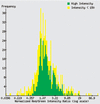The Stanford Microarray Database: data access and quality assessment tools
- PMID: 12519956
- PMCID: PMC165525
- DOI: 10.1093/nar/gkg078
The Stanford Microarray Database: data access and quality assessment tools
Abstract
The Stanford Microarray Database (SMD; http://genome-www.stanford.edu/microarray/) serves as a microarray research database for Stanford investigators and their collaborators. In addition, SMD functions as a resource for the entire scientific community, by making freely available all of its source code and providing full public access to data published by SMD users, along with many tools to explore and analyze those data. SMD currently provides public access to data from 3500 microarrays, including data from 85 publications, and this total is increasing rapidly. In this article, we describe some of SMD's newer tools for accessing public data, assessing data quality and for data analysis.
Figures


References
-
- Schena M., Shalon,D., Davis,R.W. and Brown,P.O. (1995) Quantitative monitoring of gene expression patterns with a complementary DNA microarray. Science, 270, 467–470. - PubMed
-
- Forozan F., Mahlamaki,E.H., Monni,O., Chen,Y., Veldman,R., Jiang,Y., Gooden,G.C., Ethier,S.P., Kallioniemi,A. and Kallioniemi,O.P. (2000) Comparative genomic hybridization analysis of 38 breast cancer cell lines: a basis for interpreting complementary DNA microarray data. Cancer Res., 60, 4519–4525. - PubMed
-
- Pollack J.R., Perou,C.M., Alizadeh,A.A., Eisen,M.B., Pergamenschikov,A., Williams,C.F., Jeffrey,S.S., Botstein,D. and Brown,P.O. (1999) Genome-wide analysis of DNA copy-number changes using cDNA microarrays. Nature Genet., 23, 41–46. - PubMed
MeSH terms
LinkOut - more resources
Full Text Sources
Other Literature Sources

